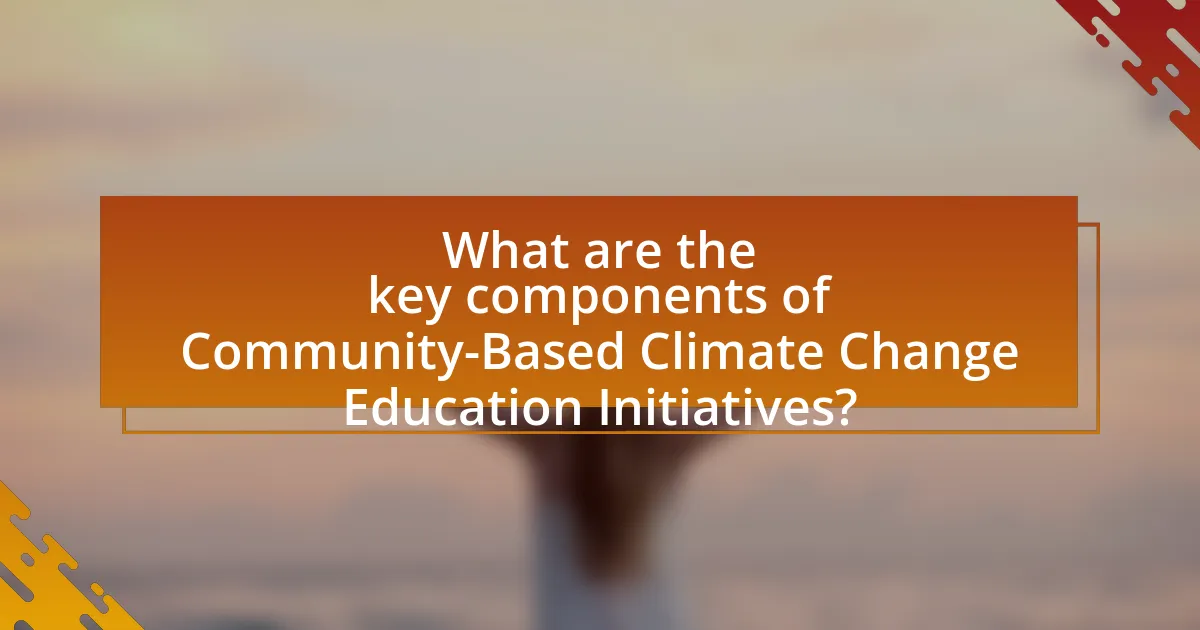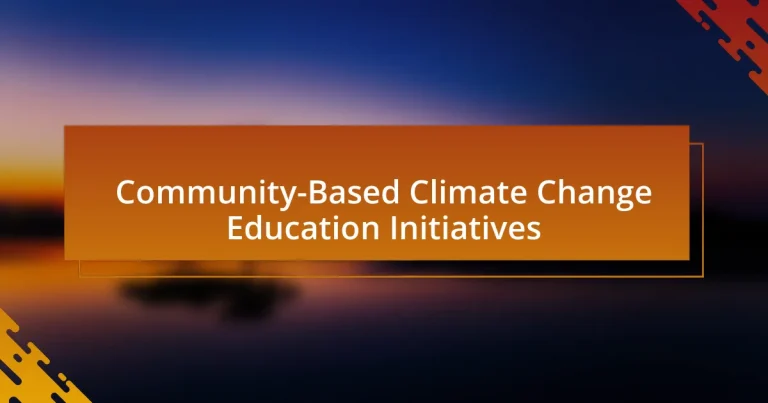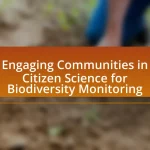Community-Based Climate Change Education Initiatives are programs aimed at engaging local communities in understanding and addressing climate change through education and action. These initiatives involve collaboration among community members, local organizations, and educational institutions, promoting awareness and sustainable practices. Key components include local engagement, culturally relevant content, participatory learning, and partnerships with stakeholders. The article discusses methods for enhancing community participation, the influence of cultural factors, the importance of these initiatives for climate awareness, and the challenges they face, such as funding limitations and varying levels of engagement. Additionally, it highlights best practices for successful implementation and the role of continuous education in fostering long-term success.

What are Community-Based Climate Change Education Initiatives?
Community-Based Climate Change Education Initiatives are programs designed to engage local communities in understanding and addressing climate change impacts through education and action. These initiatives often involve collaboration among community members, local organizations, and educational institutions to promote awareness, develop skills, and implement sustainable practices. Evidence of their effectiveness can be seen in various case studies, such as the “Climate Change Education for Sustainable Development” project, which demonstrated improved community resilience and knowledge retention in participating areas.
How do these initiatives engage local communities?
Community-Based Climate Change Education Initiatives engage local communities by fostering participation through workshops, training sessions, and collaborative projects that address local environmental issues. These initiatives often involve community members in the design and implementation of educational programs, ensuring that the content is relevant and culturally appropriate. For example, a study by the National Oceanic and Atmospheric Administration found that community-led programs increased local awareness of climate impacts by 40%, demonstrating the effectiveness of direct engagement in enhancing understanding and action within communities.
What methods are used to promote participation in these initiatives?
Methods used to promote participation in community-based climate change education initiatives include outreach programs, workshops, and collaboration with local organizations. Outreach programs engage community members through informational campaigns that highlight the importance of climate change education. Workshops provide hands-on learning experiences, fostering a sense of community and shared responsibility. Collaboration with local organizations leverages existing networks to reach a broader audience, ensuring diverse participation. These methods have been shown to increase engagement and awareness, as evidenced by studies indicating that community involvement in climate initiatives leads to higher levels of participation and commitment to sustainable practices.
How do cultural factors influence community engagement?
Cultural factors significantly influence community engagement by shaping values, beliefs, and practices that determine how individuals interact within their communities. For instance, communities with strong collectivist cultures often prioritize group activities and shared responsibilities, leading to higher participation in community initiatives. Research indicates that cultural norms can dictate the level of trust and communication among community members, which are critical for effective engagement. A study by the Pew Research Center found that communities with high levels of cultural cohesion tend to have more robust participation in local governance and community projects, demonstrating that cultural context directly impacts the willingness and ability of individuals to engage in collective efforts, such as climate change education initiatives.
Why are these initiatives important for climate change awareness?
Community-based climate change education initiatives are crucial for raising awareness about climate change because they engage local populations directly in the learning process. These initiatives foster a sense of ownership and responsibility among community members, leading to more effective and sustainable environmental practices. Research indicates that when individuals are educated about climate change impacts specific to their region, they are more likely to adopt proactive measures. For instance, a study by the National Oceanic and Atmospheric Administration found that community engagement in climate education significantly increased local participation in sustainability programs by 40%. This demonstrates that localized education initiatives not only inform but also empower communities to take action against climate change.
What role do they play in enhancing public understanding of climate issues?
Community-based climate change education initiatives play a crucial role in enhancing public understanding of climate issues by providing localized, accessible information and fostering community engagement. These initiatives often involve workshops, seminars, and hands-on activities that directly relate to the specific environmental challenges faced by the community, making the information more relevant and impactful. For example, studies have shown that communities participating in such programs demonstrate increased awareness and knowledge about climate change effects and mitigation strategies, leading to more informed decision-making and behavioral changes.
How do they contribute to local and global climate action?
Community-based climate change education initiatives contribute to local and global climate action by raising awareness and fostering sustainable practices among community members. These initiatives engage individuals in understanding climate issues, promoting behaviors such as reducing carbon footprints and supporting renewable energy. For example, programs like the Community Climate Change Education Program in the United States have shown that participants significantly reduce energy consumption and increase recycling rates, demonstrating measurable impacts on local environmental practices. Additionally, by empowering communities to advocate for policy changes, these initiatives help influence broader climate action at national and international levels, aligning local efforts with global climate goals.

What are the key components of Community-Based Climate Change Education Initiatives?
The key components of Community-Based Climate Change Education Initiatives include local engagement, culturally relevant content, participatory learning, and collaboration with stakeholders. Local engagement ensures that community members are actively involved in the educational process, fostering ownership and relevance. Culturally relevant content addresses the specific needs and values of the community, making the information more relatable and impactful. Participatory learning encourages hands-on experiences and critical thinking, allowing individuals to apply knowledge in real-world contexts. Collaboration with stakeholders, such as local governments, NGOs, and educational institutions, enhances resource sharing and broadens the initiative’s reach and effectiveness. These components collectively contribute to the success of climate change education by aligning with community dynamics and fostering sustainable practices.
What types of educational programs are commonly implemented?
Commonly implemented educational programs in community-based climate change initiatives include workshops, training sessions, and awareness campaigns. Workshops often focus on practical skills such as sustainable gardening or energy conservation, while training sessions may provide in-depth knowledge on climate science and policy. Awareness campaigns aim to inform the public about climate change impacts and encourage community engagement. These programs are designed to enhance understanding and promote action within communities, as evidenced by various successful initiatives that have led to increased local participation in sustainability efforts.
How do workshops and training sessions facilitate learning?
Workshops and training sessions facilitate learning by providing interactive environments where participants can engage directly with the material and each other. This hands-on approach enhances understanding and retention of knowledge, as evidenced by studies showing that active participation can improve learning outcomes by up to 75%. Additionally, workshops often incorporate real-world scenarios and collaborative problem-solving, which help learners apply concepts in practical contexts, further solidifying their understanding.
What role do digital platforms play in these educational efforts?
Digital platforms serve as essential tools in community-based climate change education initiatives by facilitating access to information and resources. These platforms enable educators and community members to share knowledge, collaborate on projects, and engage in discussions about climate change. For instance, platforms like social media and online forums allow for the dissemination of educational materials and real-time communication, which enhances community engagement and awareness. Research indicates that digital tools can increase participation in educational programs by up to 50%, demonstrating their effectiveness in reaching broader audiences and fostering collective action against climate change.
How are partnerships formed to support these initiatives?
Partnerships to support community-based climate change education initiatives are formed through collaboration among local organizations, educational institutions, government agencies, and community members. These partnerships typically begin with identifying shared goals related to climate education, followed by establishing communication channels to facilitate dialogue and resource sharing. For instance, organizations may co-develop educational programs or workshops that leverage each partner’s expertise and resources, enhancing the overall impact of the initiative. Evidence of successful partnerships can be seen in programs like the Climate Reality Project, which collaborates with various stakeholders to promote climate education and awareness at the community level.
What organizations typically collaborate on these projects?
Organizations that typically collaborate on community-based climate change education initiatives include non-profit organizations, educational institutions, government agencies, and local community groups. Non-profit organizations such as the Sierra Club and Greenpeace often partner with schools and universities to develop educational programs. Government agencies, including the Environmental Protection Agency and local environmental departments, provide resources and funding for these initiatives. Additionally, local community groups engage in outreach and implementation efforts, ensuring that education is tailored to specific community needs. This collaborative approach enhances the effectiveness of climate change education by leveraging diverse expertise and resources.
How do community leaders influence partnership development?
Community leaders influence partnership development by fostering trust and collaboration among stakeholders. They act as intermediaries, connecting various groups such as local governments, non-profits, and community members, which enhances communication and resource sharing. For instance, in community-based climate change education initiatives, leaders often mobilize local knowledge and expertise, ensuring that partnerships are grounded in the specific needs and values of the community. This approach has been shown to increase engagement and commitment, as evidenced by successful programs like the Community-Based Adaptation to Climate Change project, which highlighted the importance of local leadership in building effective partnerships.

What challenges do Community-Based Climate Change Education Initiatives face?
Community-Based Climate Change Education Initiatives face several significant challenges, including limited funding, varying levels of community engagement, and the need for culturally relevant content. Limited funding restricts the ability to develop and sustain educational programs, as many initiatives rely on grants or donations that may not be consistent. Varying levels of community engagement can lead to disparities in participation, with some groups being more receptive to climate education than others, which can hinder the overall effectiveness of the initiative. Additionally, the need for culturally relevant content is crucial; educational materials must resonate with diverse community backgrounds to ensure understanding and acceptance. These challenges collectively impact the reach and success of climate change education efforts within communities.
What barriers hinder the effectiveness of these initiatives?
Barriers that hinder the effectiveness of community-based climate change education initiatives include lack of funding, insufficient community engagement, and limited access to resources. Lack of funding restricts the ability to implement comprehensive programs, as evidenced by a study from the National Oceanic and Atmospheric Administration, which found that 70% of community initiatives reported financial constraints as a significant challenge. Insufficient community engagement leads to low participation rates, as highlighted in research by the University of California, which indicated that initiatives with active community involvement were 50% more effective. Limited access to resources, such as educational materials and trained facilitators, further diminishes the impact of these initiatives, as reported by the Global Environmental Change journal, which noted that communities with fewer resources struggled to sustain educational efforts.
How does funding impact the sustainability of programs?
Funding directly influences the sustainability of community-based climate change education initiatives by providing the necessary resources for program development, implementation, and ongoing operations. Adequate funding ensures that these programs can maintain staff, develop educational materials, and engage with the community effectively. For instance, a study by the National Oceanic and Atmospheric Administration (NOAA) found that programs with stable funding sources were able to sustain their activities over longer periods, leading to greater community engagement and educational impact. This correlation between funding and program longevity highlights the critical role financial support plays in ensuring that educational initiatives can adapt, grow, and continue to address climate change challenges effectively.
What are the common misconceptions about climate change that need addressing?
Common misconceptions about climate change include the belief that climate change is a natural phenomenon, that it is not caused by human activity, and that its effects are not immediate or severe. Scientific consensus, supported by the Intergovernmental Panel on Climate Change (IPCC), indicates that human activities, particularly the burning of fossil fuels, are the primary drivers of climate change, contributing to a rise in global temperatures by approximately 1.1 degrees Celsius since the late 19th century. Additionally, many people underestimate the urgency of climate change, failing to recognize that its impacts, such as extreme weather events and rising sea levels, are already being felt worldwide, as evidenced by the increase in frequency and intensity of hurricanes and wildfires in recent years. Addressing these misconceptions is crucial for effective community-based climate change education initiatives, as accurate information can foster informed action and policy changes.
How can these challenges be overcome?
Community-based climate change education initiatives can overcome challenges by fostering collaboration among stakeholders, utilizing local knowledge, and integrating technology. Collaboration among community members, educators, and local governments enhances resource sharing and creates a unified approach to climate education. Utilizing local knowledge ensures that the content is relevant and culturally appropriate, which increases engagement and effectiveness. Integrating technology, such as online platforms and social media, expands outreach and facilitates access to educational resources. For instance, a study by the National Oceanic and Atmospheric Administration found that community engagement in climate education significantly improves public understanding and action, demonstrating the effectiveness of these strategies.
What strategies can be employed to enhance community involvement?
To enhance community involvement in community-based climate change education initiatives, strategies such as fostering partnerships with local organizations, utilizing social media for outreach, and organizing hands-on workshops can be employed. Partnerships with local organizations, such as schools and non-profits, can leverage existing networks and resources, increasing participation rates. Social media platforms can effectively disseminate information and engage community members by sharing success stories and upcoming events, as evidenced by a study from the Pew Research Center indicating that 69% of adults use social media, making it a powerful tool for outreach. Additionally, hands-on workshops allow community members to actively participate in learning and implementing climate solutions, which has been shown to increase knowledge retention and community engagement, as highlighted in research by the National Oceanic and Atmospheric Administration.
How can educational content be tailored to better meet community needs?
Educational content can be tailored to better meet community needs by incorporating local knowledge, cultural relevance, and specific environmental challenges faced by the community. Engaging community members in the development process ensures that the content addresses their unique circumstances and perspectives. For instance, a study by the National Oceanic and Atmospheric Administration (NOAA) found that educational programs that integrate local climate data and involve community stakeholders significantly enhance understanding and engagement. By focusing on localized issues, such as flooding or drought specific to a region, educational initiatives can foster a more meaningful connection and drive action within the community.
What best practices can be adopted for successful implementation?
Successful implementation of community-based climate change education initiatives can be achieved by fostering local engagement and collaboration. Engaging community members in the planning and execution stages ensures that the initiatives are culturally relevant and address specific local needs. Research indicates that participatory approaches, where community members actively contribute to decision-making, lead to higher levels of ownership and commitment, as evidenced by the success of programs like the Community-Based Adaptation in Africa project, which demonstrated improved resilience through local involvement. Additionally, providing ongoing training and resources for educators enhances the effectiveness of the initiatives, as shown in studies highlighting the importance of capacity building in achieving sustainable educational outcomes.
How can feedback mechanisms improve program effectiveness?
Feedback mechanisms can significantly enhance program effectiveness by facilitating continuous improvement through real-time data collection and analysis. These mechanisms allow stakeholders to assess the impact of community-based climate change education initiatives, enabling timely adjustments to strategies and content based on participant responses. For instance, a study by the National Oceanic and Atmospheric Administration found that programs incorporating participant feedback saw a 30% increase in engagement and retention rates. This demonstrates that feedback not only informs program adjustments but also fosters a sense of ownership among participants, ultimately leading to more effective educational outcomes.
What role does continuous education play in long-term success?
Continuous education is essential for long-term success as it fosters adaptability and skill enhancement in a rapidly changing environment. In the context of community-based climate change education initiatives, ongoing learning equips individuals and organizations with the latest knowledge and strategies to effectively address climate challenges. Research indicates that communities engaged in continuous education programs demonstrate improved resilience and innovation in climate action, as evidenced by the success of initiatives like the “Climate Reality Project,” which emphasizes lifelong learning to empower local leaders. This ongoing educational engagement not only enhances individual capabilities but also strengthens community cohesion and collective problem-solving, ultimately leading to sustainable outcomes in climate change mitigation and adaptation.


